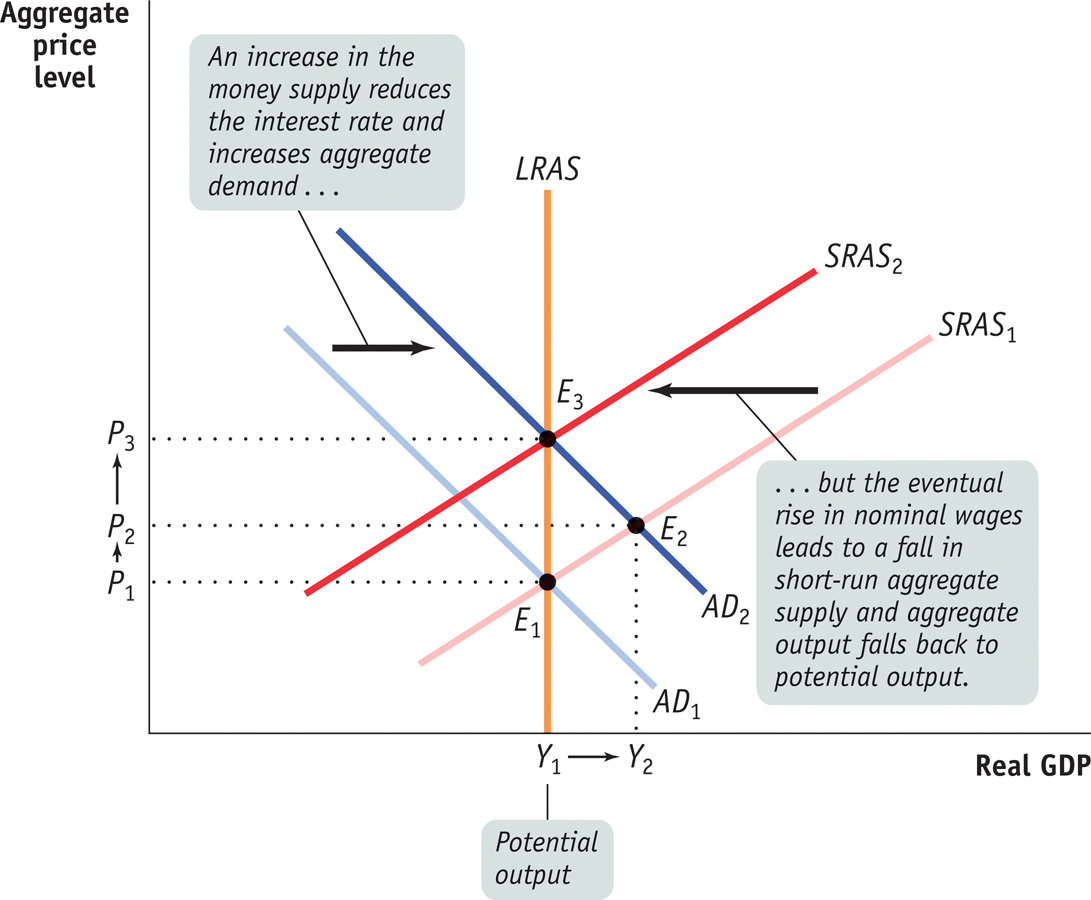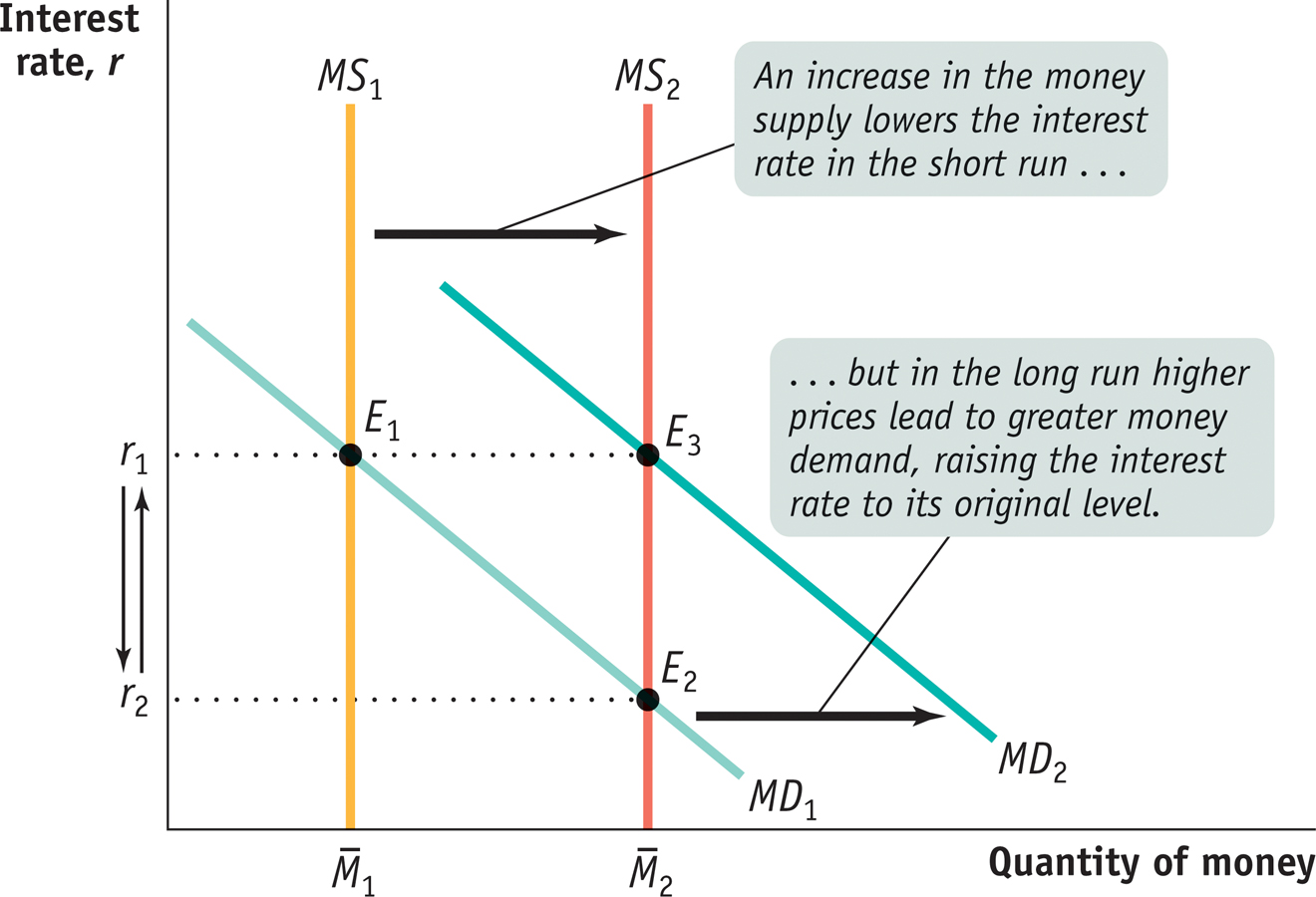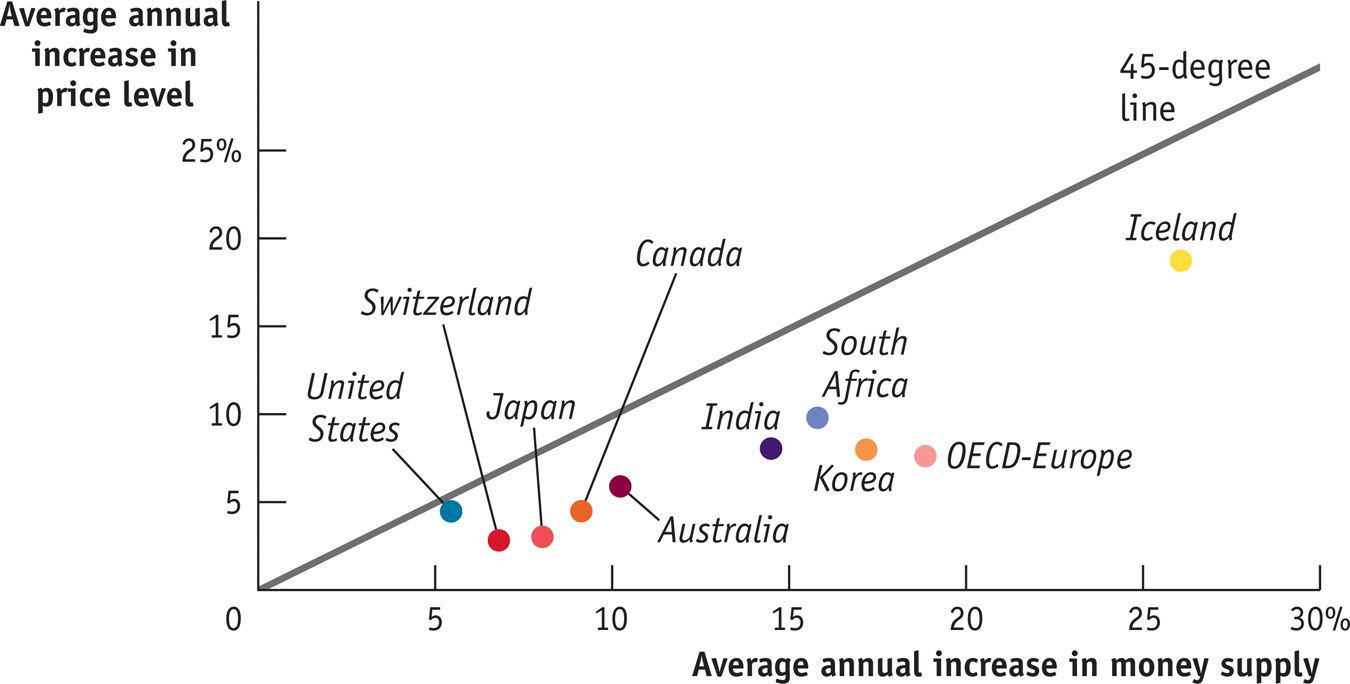1.4 75Money, Output, and Prices in the Long Run

WHAT YOU WILL LEARN
 The effects of an inappropriate monetary policy
The effects of an inappropriate monetary policy
 The concept of monetary neutrality and its relationship to the long-
The concept of monetary neutrality and its relationship to the long-run economic effects of monetary policy
In the previous module we discussed how expansionary and contractionary monetary policy can be used to stabilize the economy. The Federal Reserve can use its monetary policy tools to change the money supply and cause the equilibrium interest rate in the money market to increase or decrease.
But what if a central bank pursues a monetary policy that is not appropriate? That is, what if a central bank pursues expansionary policy during an expansion or contractionary policy during a recession? In this module we consider how a counterproductive action by a central bank can actually destabilize the economy in the short run.
We also introduce the long-
Money, Output, and Prices
Because of its expansionary and contractionary effects, monetary policy is generally the policy tool of choice to help stabilize the economy. However, not all actions by central banks are productive. Central banks sometimes print money not to fight a recessionary gap but to help the government pay its bills, an action that typically destabilizes the economy.
What happens when a change in the money supply pushes the economy away from, rather than toward, long-
To see why, let’s look at what happens if the central bank permanently increases the money supply.
Short-Run and Long-Run Effects of an Increase in the Money Supply
To analyze the long-
Figure 75-1 shows the short-

Now suppose there is an increase in the money supply. Other things equal, an increase in the money supply reduces the interest rate, which increases investment spending, which leads to a further rise in consumer spending, and so on. So an increase in the money supply increases the quantity of goods and services demanded, shifting the AD curve rightward to AD2.
In the short run, the economy moves to a new short-
But the aggregate output level Y2 is above potential output. As a result, nominal wages will rise over time, causing the short-
The long-
If the money supply decreases, the story we have just told plays out in reverse. Other things equal, a decrease in the money supply raises the interest rate, which decreases investment spending, which leads to a further decrease in consumer spending, and so on. So a decrease in the money supply decreases the quantity of goods and services demanded at any given aggregate price level, shifting the aggregate demand curve to the left.
In the short run, the economy moves to a new short-
But what happens over time? When the aggregate output level is below potential output, nominal wages fall. When this happens, the short-
The long-
Monetary Neutrality
How much does a change in the money supply change the aggregate price level in the long run? The answer is that a change in the money supply leads to a proportional change in the aggregate price level in the long run. For example, if the money supply falls 25%, the aggregate price level falls 25% in the long run; if the money supply rises 50%, the aggregate price level rises 50% in the long run.
How do we know this? Consider the following thought experiment: suppose all prices in the economy—

We can state this argument in reverse: if the economy starts out in long-
According to the concept of monetary neutrality, changes in the money supply have no real effects on the economy in the long run.
This analysis demonstrates the concept known as monetary neutrality, in which changes in the money supply have no real effects on the economy. In the long run, the only effect of an increase in the money supply is to raise the aggregate price level by an equal percentage. Economists argue that money is neutral in the long run.
This is, however, a good time to recall the dictum of John Maynard Keynes: “In the long run we are all dead.” In the long run, changes in the money supply don’t have any effect on real GDP, interest rates, or anything else except the price level.
But it would be foolish to conclude from this that the Fed is irrelevant. Monetary policy does have powerful real effects on the economy in the short run, often making the difference between recession and expansion. And that matters a lot for society’s welfare.
Changes in the Money Supply and the Interest Rate in the Long Run
In the short run, an increase in the money supply leads to a fall in the interest rate, and a decrease in the money supply leads to a rise in the interest rate. We have explained that in the long run it’s a different story: changes in the money supply don’t affect the interest rate at all. Let’s look at why.
Figure 75-2 shows why. It shows the money supply curve and the money demand curve before and after the Fed increases the money supply. We assume that the economy is initially at E1, in long- . The initial equilibrium interest rate, determined by the intersection of the money demand curve MD1 and the money supply curve MS1, is r1.
. The initial equilibrium interest rate, determined by the intersection of the money demand curve MD1 and the money supply curve MS1, is r1.

 to
to  pushes the interest rate down from r1 to r2 and the economy moves to E2, a short-
pushes the interest rate down from r1 to r2 and the economy moves to E2, a short-Now suppose the money supply increases from  to
to  . In the short run, the economy moves from E1 to E2 and the interest rate falls from r1 to r2. Over time, however, the aggregate price level rises, and this raises money demand, shifting the money demand curve rightward from MD1 to MD2. The economy moves to a new long-
. In the short run, the economy moves from E1 to E2 and the interest rate falls from r1 to r2. Over time, however, the aggregate price level rises, and this raises money demand, shifting the money demand curve rightward from MD1 to MD2. The economy moves to a new long-
And it turns out that the long-
- Because of monetary neutrality, in the long run the aggregate price level rises by the same proportion as the money supply; so if the money supply rises by, say, 50%, the price level will also rise by 50%.
- The demand for money is, other things equal, proportional to the aggregate price level. So a 50% increase in the money supply raises the aggregate price level by 50%, which increases the quantity of money demanded at any given interest rate by 50%. As a result, the quantity of money demanded at the initial interest rate, r1, rises exactly as much as the money supply—
so that r1 is still the equilibrium interest rate.
In the long run, then, changes in the money supply do not affect the interest rate.
INTERNATIONAL EVIDENCE OF MONETARY NEUTRALITY
These days monetary policy is quite similar among wealthy countries. Each major nation (or, in the case of the euro, the euro area) has a central bank that is insulated from political pressure. All of these central banks try to keep the aggregate price level roughly stable, which usually means inflation of, at most, 2% to 3% per year.
But if we look at a longer period and a wider group of countries, we see large differences in the growth of the money supply. Between 1970 and the present, the money supply rose only a few percent per year in some countries, such as Switzerland and the United States, but rose much more rapidly in some poorer countries, such as South Africa.
These differences allow us to see whether increases in the money supply in the long run really do lead to equal percent rises in the aggregate price level.
Figure 75-3 shows the annual percentage increases in the money supply and average annual increases in the aggregate price level—

If the relationship between increases in the money supply and changes in the aggregate price level were exact, the points would lie precisely on a 45-
But the scatter of points clearly lies close to a 45-
75
Solutions appear at the back of the book.
Check Your Understanding
Suppose the economy begins in long-
run macroeconomic equilibrium. What is the long- run effect on the aggregate price level of a 5% increase in the money supply? Explain. A 5% increase in the money supply will cause a 5% increase in the aggregate price level in the long run. The process begins in the short run, when the larger money supply decreases the interest rate and promotes investment spending. Investment spending is a component of aggregate demand, so the increase in investment spending leads to an increase in aggregate demand, which causes real GDP to increase beyond potential output. The resulting upward pressure on nominal wages and other input prices shifts aggregate supply to the left until a new long-run equilibrium is reached. Although real GDP returns to its original level, both the increase in aggregate demand and the decrease in aggregate supply cause the aggregate price level to increase. The end result is 5% more money being spent on the same quantity of goods and services, which could only mean a 5% increase in the aggregate price level.Again supposing the economy begins in long-
run macroeconomic equilibrium, what is the long- run effect on the interest rate of a 5% increase in the money supply? Explain. A 5% increase in the money supply will have no effect on the interest rate in the long run. As explained in the previous answer, a 5% increase in the money supply is matched by a 5% increase in the aggregate price level in the long run. Changes in the aggregate price level, in turn, cause proportional changes in the demand for money. So a 5% increase in the aggregate price level increases the quantity of money demanded at any given interest rate by 5%. This means that at the initial interest rate, the quantity of money demanded rises exactly as much as the money supply, and the new, long-run interest rate is therefore no different from the initial interest rate.
Multiple-
Question
In the long run, changes in the quantity of money affect which of the following?
I. real aggregate output
II. interest rates
III. the aggregate price levelA. B. C. D. E. Question
An increase in the money supply will lead to which of the following in the short run?
A. B. C. D. E. Question
A 10% decrease in the money supply will change the aggregate price level in the long run by
A. B. C. D. E. Question
Monetary neutrality means that, in the long run, changes in the money supply
A. B. C. D. E. Question
A graph of percentage increases in the money supply and average annual increases in the price level for various countries provides evidence that
A. B. C. D. E.
Critical-
Draw a graph of aggregate demand and supply showing an economy in long-
run macroeconomic equilibrium. Your graph should look like this.
On your graph, show what happens in the short run if the central bank increases the money supply to pay off a government deficit. Explain.
The aggregate demand curve shifts to the right, creating a new equilibrium price level and real GDP. The higher money supply leads to a lower interest rate, which increases investment spending and consumer spending, and in turn aggregate demand.On your graph, show what will happen in the long run. Explain.
Wages rise over time, shifting short-run aggregate supply to the left. This brings equilibrium back to potential output with a higher price level.